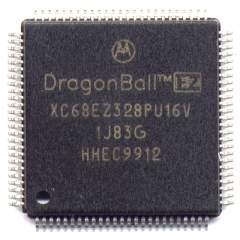
Motorola/Freescale Semiconductor's DragonBall, or MC68328, is a microcontroller design based on the famous 68000 core, but implemented as an all-in-one low-power system for handheld computer use. It is supported by μClinux. It was designed by Motorola in Hong Kong and released in 1995.

The Motorola 68000 is a 16/32-bit complex instruction set computer (CISC) microprocessor, introduced in 1979 by Motorola Semiconductor Products Sector.

The Motorola 68020 is a 32-bit microprocessor from Motorola, released in 1984. A lower cost version was also made available, known as the 68EC020. In keeping with naming practices common to Motorola designs, the 68020 is usually referred to as the "020", pronounced "oh-two-oh" or "oh-twenty".

The Motorola 68060 ("sixty-eight-oh-sixty") is a 32-bit microprocessor from Motorola released in 1994. It is the successor to the Motorola 68040 and is the highest performing member of the 68000 series. Two derivatives were produced, the 68LC060 and the 68EC060.

The 68HC11 is an 8-bit microcontroller (µC) family introduced by Motorola in 1984. Now produced by NXP Semiconductors, it descended from the Motorola 6800 microprocessor by way of the 6801. The 68HC11 devices are more powerful and more expensive than the 68HC08 microcontrollers, and are used in automotive applications, barcode readers, hotel card key writers, amateur robotics, and various other embedded systems. The MC68HC11A8 was the first microcontroller to include CMOS EEPROM.

PowerPC is a reduced instruction set computer (RISC) instruction set architecture (ISA) created by the 1991 Apple–IBM–Motorola alliance, known as AIM. PowerPC, as an evolving instruction set, has been named Power ISA since 2006, while the old name lives on as a trademark for some implementations of Power Architecture–based processors.
The Motorola 68000 series is a family of 32-bit complex instruction set computer (CISC) microprocessors. During the 1980s and early 1990s, they were popular in personal computers and workstations and were the primary competitors of Intel's x86 microprocessors. They were best known as the processors used in the early Apple Macintosh, the Sharp X68000, the Commodore Amiga, the Sinclair QL, the Atari ST, the Sega Genesis, the Capcom System I (Arcade), the AT&T UNIX PC, the Tandy Model 16/16B/6000, the Sun Microsystems Sun-1, Sun-2 and Sun-3, the NeXT Computer, NeXTcube, NeXTstation, and NeXTcube Turbo, the Texas Instruments TI-89/TI-92 calculators, the Palm Pilot and the Space Shuttle. Although no modern desktop computers are based on processors in the 680x0 series, derivative processors are still widely used in embedded systems.

Freescale Semiconductor, Inc. was an American semiconductor manufacturer. It was created by the divestiture of the Semiconductor Products Sector of Motorola in 2004. Freescale focused their integrated circuit products on the automotive, embedded and communications markets. It was bought by a private investor group in 2006, and subsequently merged into NXP Semiconductors in 2015.

μClinux is a variation of the Linux kernel, previously maintained as a fork, that targets microcontrollers without a memory management unit (MMU). It was integrated into the mainline kernel as of 2.5.46; the project continues to develop patches and tools for microcontrollers. The homepage lists Linux kernel releases for 2.0, 2.4 and 2.6.
CodeWarrior is an integrated development environment (IDE) published by NXP Semiconductors for editing, compiling, and debugging software for several microcontrollers and microprocessors and digital signal controllers used in embedded systems.

Xcopilot is a Palm Pilot emulator that runs under Unix/X11.
Nios II is a 32-bit embedded processor architecture designed specifically for the Altera family of field-programmable gate array (FPGA) integrated circuits. Nios II incorporates many enhancements over the original Nios architecture, making it more suitable for a wider range of embedded computing applications, from digital signal processing (DSP) to system-control.
The 68HC08 is a broad family of 8-bit microcontrollers originally from Motorola Semiconductor, later from Freescale Semiconductor.
LatticeMico32 is a 32-bit microprocessor reduced instruction set computer (RISC) soft core from Lattice Semiconductor optimized for field-programmable gate arrays (FPGAs). It uses a Harvard architecture, which means the instruction and data buses are separate. Bus arbitration logic can be used to combine the two buses, if desired.
The 9S08 is a 8-bit microcontroller (µC) family originally produced by Motorola, later by Freescale Semiconductor, and currently by NXP, descended from the Motorola 6800 microprocessor. It is a CISC microcontroller. A slightly extended variant of the 68HC08, it shares upward compatibility with the aging 68HC05 microcontrollers, and is found in almost any type of embedded systems. The larger members offer up to 128 KiB of flash, and 8 KiB of RAM via a simple MMU which allows bank-switching 16 KiB of the address space and an address/data register pair which allows data fetches from any address. The paging scheme used allows for a theoretical maximum of 4MB of flash.

The ARM Cortex-A9 MPCore is a 32-bit multi-core processor that provides up to 4 cache-coherent cores, each implementing the ARM v7 architecture instruction set. It was introduced in 2007.

The ARM Cortex-M is a group of 32-bit RISC ARM processor cores licensed by Arm Holdings. These cores are optimized for low-cost and energy-efficient integrated circuits, which have been embedded in tens of billions of consumer devices. Though they are most often the main component of microcontroller chips, sometimes they are embedded inside other types of chips too. The Cortex-M family consists of Cortex-M0, Cortex-M0+, Cortex-M1, Cortex-M3, Cortex-M4, Cortex-M7, Cortex-M23, Cortex-M33, Cortex-M35P, Cortex-M55. The Cortex-M4 / M7 / M33 / M35P / M55 cores have an FPU silicon option, and when included in the silicon these cores are sometimes known as "Cortex-Mx with FPU" or "Cortex-MxF", where 'x' is the core variant.












